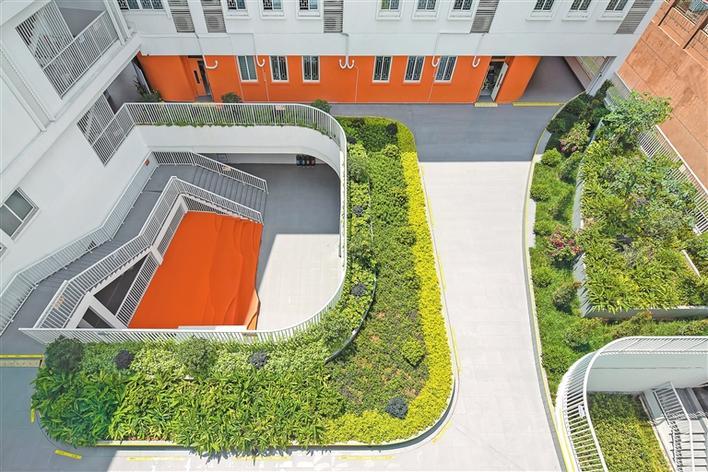The first "new national standard" green school in Guangdong Province landed in Shenzhen City
Author:www.new.qq.com
Time:09/08/2021
The first "New National Standard" green school project in Guangdong Province, the Nanwan Experimental Primary School Project in Longgang District, passed the "New National Standard" two-star green building review.
Green is the color of life and the foundation of ecology. Green to architecture is intended to give life to the building, to make the "solidified" building full of vigor and vitality, to make it coordinate with the environment and symbiotic with nature. Green building is the view of the whole life of the building, the protection and care of users, the attitude of respecting nature, and the creation of poetic homes.
Recently, the first "New National Standard" green school project in Guangdong Province, the Nanwan Experimental Primary School Project in Longgang District, passed the "New National Standard" two-star green building review organized by the Shenzhen Green Building Association. This marks Shenzhen's first demonstration in the construction field and an important step forward in creating high-quality buildings and creating a green and livable city.
Green becomes the main theme of the campus
Nanwan Experimental Primary School is located in Nanwan Street, Longgang District. The project was designed and consulted by Jianxue Architectural and Engineering Design Institute Co., Ltd. The school is composed of 2 teaching complexes and 1 teachers’ dormitory, with a total of 24 classes. After the school is completed, the difficulty of enrolling students in the surrounding areas has been greatly eased.
Walking into the school, green and natural come to your face. The reporter saw here that not only the school’s buildings are lively and beautiful, but the care for the safety and health of students is reflected everywhere. What’s more commendable is that the detailed design of “seeing the needles” makes “seeing green everywhere” a characteristic of the school. The organic integration of campus architecture, ecological environment and the needs of teachers and students is the new campus life brought to people by green buildings.
The children’s teaching space is dominated by white facades, showing the atmosphere of calm and self-discipline, while the activity space is dominated by orange facades, showing the agile temperament of jumping and moving, complementing each other. Various green plants are planted in every corner of the campus, making green the "main theme" of the campus. The roof of the teaching building is completely greened, which not only adds greenery and negative ions, but also achieves the function of dissipating heat for the top classrooms. The roof is specially equipped with bird's nest and bird-introducing plants. Children can often hear the sound of nature's birdsong in the classroom, which contrasts with the sound of reading aloud. In terms of the practical functions of campus buildings, the people-oriented concept is also reflected everywhere. On the semi-sinking raised floor, in order to make the children have a better air environment when they are moving here, a professional airflow design is adopted, which ingeniously solves the ventilation problem of the lower floors. In addition, the design of indoor lighting, classroom orientation, and safety facilities also reflects more green and humanistic care.
The new national standard highlights the green design concept
Yu Tianchi, the director and chief architect of the Jianxue Architecture and Engineering Design Institute Co., Ltd., the person in charge of the project design, introduced to reporters that the "New National Standard", the "Green Building Evaluation Standard", which was implemented on August 1, 2019, restructured the green building evaluation technical indicator system. The original seven index systems of “land saving, energy saving, water saving, material saving, indoor environment, construction management, and operation management” were updated to the five index systems of “safe and durable, healthy and comfortable, convenient life, resource saving and environment livable”. It aims to implement the changes in the main social contradictions proposed by the 19th National Congress of the Communist Party of China, improve the quality of buildings, and improve the sense of gain and happiness of the people. It is of great significance to the implementation of the concept of green development in the construction field. The "new national standard" has generally reached the international leading level, and a new pattern of "leading" the world's green building standards has initially formed.
"The new national standard has brought about a change in the design concept of green buildings from 'green technology' to 'green design', which more embodies the integration of architecture, people and nature. Moreover, the evaluation and acceptance are also stricter. The new national standard requires that the evaluation of green buildings can only be carried out after the construction project is completed, so that it can urge the green building project to be more effectively implemented instead of just focusing on the design. "
Yu Tianchi revealed that the Nanwan Experimental Primary School project is the beginning of Shenzhen's implementation of the "new national standard" green building. In the future, all new schools in our city will be designed and reviewed in accordance with the "new national standard".
"Green perception" integrated into livable city life
As a local architect who has been rooted in Shenzhen for 30 years, Yu Tianchi has in-depth research on green building design practices and green buildings. He summed up the core of the green building design in Lingnan area as "green, shade, permeable, water, material, and energy". He emphasized that green design should be adapted to local conditions and different considerations should be made according to the regional climate. "For example, the climate in Shenzhen is humid, hot, and stuffy, which requires targeted solutions in the design, which is also part of the green building."
At present, my country is actively deploying carbon peaks and carbon neutrality, and achieving energy conservation and emission reduction is an important part of the green building standards. "In the Nanwan Experimental Primary School project, through the use of level 1 water-saving appliances, drip irrigation systems, and soil moisture sensors, the water saving rate reached more than 15%. Design a rainwater recycling system to collect part of the road and roof rainwater, and use it for green irrigation, etc.; implement the sponge city concept by setting up sunken green spaces, infiltration canals, permeable paving and roof greening. The use of solar thermal energy to solve domestic hot water can save about 18,500 yuan in electricity bills every year... These are all requirements for green buildings. "
Green buildings and green campuses bring beautiful, healthy and comfortable working and learning environment to teachers and students. In April this year, when the Nanwan Experimental Primary School was put into use for half a year, the designer conducted a questionnaire for teachers and students around "green perception". The survey shows that more than 80% of teachers and students have affirmed the comfort of campus greening and indoor and outdoor environments.
Green, really came to everyone, walked into everyone's heart.




 苏公网安备 32041102000002号
苏公网安备 32041102000002号